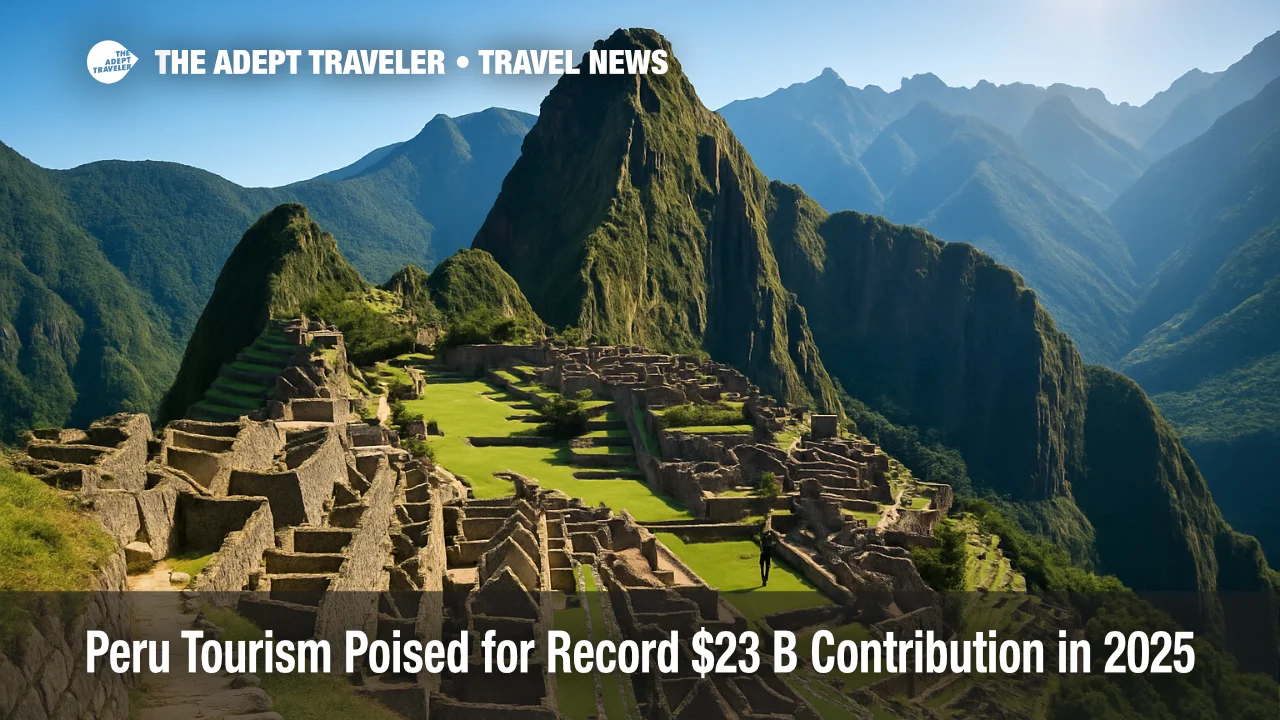Peru Tourism Poised for Record $23 B Contribution in 2025

Peru's travel economy is on a growth tear. The World Travel and Tourism Council (WTTC) now forecasts that the sector will pump a record $23 billion into Peru's GDP this year-7.8 percent of national output-while supporting 1.17 million jobs. Strong domestic demand, resurgent international arrivals, and sustained government promotion are combining to push the Andean nation's visitor economy beyond pre-pandemic highs. For travelers, the outlook translates into better connectivity, refreshed infrastructure, and broader choices across Peru's historic and nature-rich regions.
Key Points
- Why it matters: Record $23 billion GDP impact expected in 2025
- Jobs to hit 1.17 million, up 8.4 percent on 2019
- Domestic spending projected at $12 billion, international at $5 billion
- Leisure travel makes up 86 percent of total outlays
- Main source markets: Chile, the United States, and Ecuador
Snapshot
Peru's visitor economy has bounced back faster than many of its regional peers. WTTC data show a 6.9 percent year-over-year expansion expected by December 31, boosting travel's share of GDP to 7.8 percent. Domestic travelers remain the backbone, with spending set to exceed $12 billion-an annual rise of 6.5 percent-while foreign visitors are forecast to inject more than $5 billion, up 9.4 percent. Leisure dominates at 86 percent of total spend, underscoring Peru's pull as a bucket-list destination for archaeology, cuisine, and outdoor adventure. Business travel, meanwhile, holds a 13.8 percent slice, signaling gradual recovery in the meetings market.
Background
Last year laid the groundwork for 2025's record figures. The sector delivered $21.6 billion in GDP value-7.5 percent of the economy-and employed 1.11 million Peruvians. International receipts surged nearly 22 percent to $4.7 billion, while domestic outlays climbed 9 percent to $11.4 billion. Crucially, visitor dispersal improved as carriers restored pre-COVID capacity into Lima's Jorge Chávez International Airport (LIM) and secondary hubs such as Cusco (CUZ). Government marketing campaigns spotlighted regions beyond Machu Picchu, driving traffic to northern beach circuits and the Amazon basin. These moves, paired with streamlined entry protocols, primed Peru for its current growth spurt.
Latest Developments
Domestic Spending Keeps Climbing
Local travelers continue to power Peru's tourism engine. Rising disposable incomes and aggressive airline fare promotions have pushed domestic trip frequencies above 2019 levels. WTTC expects in-country tourism to reach $12 billion this year, helped by improved road links between Lima, Arequipa, and the Sacred Valley, plus a wave of mid-scale hotel openings aimed at national vacationers. Authorities are also rolling out digital ticketing for heritage sites, smoothing peak-season crowd flows and reinforcing preservation funding.
Regional Tourism Outpaces Pre-COVID Benchmarks
Across Central and South America, travel and tourism is forecast to contribute $372 billion to regional GDP in 2025-7.6 percent of economic activity. Employment should reach 18.2 million jobs, a fresh high that eclipses 2019 by 9 percent. Peru's own advance mirrors this trend but outperforms on growth rate, underscoring the country's rising stature as a gateway to Andean culture and Amazonian biodiversity. Improved code-share agreements with LATAM, SKY Airline, and JetSMART are widening access from key feeder cities in Chile and Ecuador, while U.S. carriers expand seasonal lift to resort hubs like Piura and Trujillo.
Analysis
Peru's accelerated rebound rests on three pillars: connectivity, product diversification, and policy stability. Airport upgrades at LIM and planned runway extensions in Cusco will raise annual capacity, easing bottlenecks that once deterred high-yield segments. Meanwhile, tour operators have shifted focus from one-and-done classics to multi-center itineraries that stitch together colonial architecture, UNESCO-listed ruins, and emerging gastronomic corridors. This disperses economic benefits and reduces pressure on marquee attractions. On the policy front, consistent messaging from tourism authorities and a measured visa regime have kept Peru competitive within the region. The WTTC baseline assumes macroeconomic headwinds stay moderate; larger-than-expected currency swings or supply-chain hiccups could temper growth, yet structural fundamentals-youthful workforce, rich cultural assets, and pro-investment stance-suggest long-run resilience.
Final Thoughts
For travelers eyeing Peru in 2025, the numbers translate into more flight options, refreshed visitor services, and new routes that knit together coast, mountain, and jungle. Early booking remains wise for peak seasons at Machu Picchu and the Sacred Valley, but broader infrastructure investment should ease pressure elsewhere. If WTTC projections hold, Peru will stand as one of Latin America's brightest tourism performers, cementing its appeal for adventurous visitors and heritage lovers alike-and exemplifying Peru tourism growth 2025.
